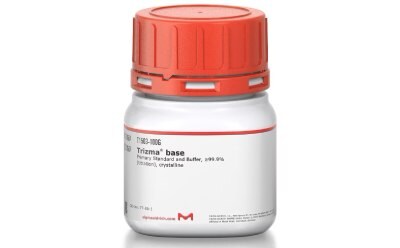Tris

Tris, also referred to as THAM (Tris(hydroxymethyl)aminomethane), is a white crystalline powder. Tris buffer has a pKa of approximately 8.1 at 25°C making it a good choice for most biological processes in the pH range of 7-9. Compared to other specialized buffers like HEPES, tris powder is a cost-effective and more robust option.
Tris buffer solutions are prepared by dissolving tris base in water and adjusting the pH with acid, typically hydrochloric acid, or sulfuric acid. The resulting solution serves as a reliable pH regulator and stabilizer in a variety of experimental settings, including protein biochemistry, molecular biology, and enzymology as well as techniques like electrophoresis, Enzyme-Linked Immunosorbent Assay (ELISA), and chromatography processes. Also, in cell culture, tris buffer helps in maintaining the optimal pH environment essential for cell growth, proliferation, and the maintenance of physiological conditions in cell culture media.
Tris buffer is available in various forms, including pre-made solutions or as a powder, thus making it convenient for laboratory use.
Tris HCl
Tris HCl or tris hydrochloride (also known as Trizma HCl) is a buffering agent (acidic buffer) commonly used in molecular biology and biochemical settings to adjust the pH of a solution or stabilize the pH. Similar to tris base, tris HCl is also a white crystalline powder with a molecular formula of C4H12ClNO3 and a slightly higher molecular weight of 157.60. The key distinction lies in the addition of hydrochloric acid to tris base, resulting in the formation of Tris HCl. While Tris base has a pKa of around 8.1, which allows it to function as a buffer within the pH range of 7-9, Tris HCl already contains hydrochloric acid. This addition lowers the pH, making Tris HCl suitable for buffering within the pH range of 7.0-8.6.
Tris base serves as a versatile buffer over a wide pH range, while Tris HCl offers a more specific pH range due to its hydrochloric acid content. The selection between Tris and Tris HCl depends on the desired pH range and specific experimental or application needs.
Tris Buffered Saline (TBS)
Tris Buffered Saline (TBS) is a buffer commonly used in biological and biochemical applications. It typically contains Tris(hydroxymethyl)aminomethane, or Tris for short, a buffering agent that maintains a constant pH, and sodium chloride, which provides the necessary ionic strength. TBS has a relatively neutral pH (around 7.4) and is widely used for applications like Western blotting, immunohistochemistry, and ELISA assays. TBS is also used as a wash buffer to remove unbound antibodies or other reagents from the sample. The concentration of Tris and sodium chloride can vary depending on the specific application, but a commonly used formulation is 50 mM Tris and 150 mM sodium chloride.
Tris Acetate EDTA (TAE)
TAE buffer is another commonly used buffer in molecular biology, electrophoresis, and for northern and southern blotting. In TAE buffer, tris functions as a buffering agent, acetic acid contributes to the buffering capacity, and EDTA (ethylenediaminetetraacetic acid) acts as a chelating agent. TAE is widely used as a running buffer in agarose gel electrophoresis, DNA fragment analysis, pulsed-field gel electrophoresis (to determine the size of DNA fragments), RNA electrophoresis, and nucleic acid transfer.
Tris Borate EDTA (TBE)
TBE buffer is widely used to separate and analyze DNA fragments, especially for achieving higher-resolution in the separation of smaller DNA fragments. In TBE buffer, boric acid plays a significant role in maintaining the buffering capacity of the solution. TBE buffer finds applications in various techniques, including, agarose gel electrophoresis, DNA sequencing, polymerase chain reactions (PCR) product analysis, oligonucleotide analysis, denaturing gel electrophoresis, and in native gel electrophoresis.
Tris Glycine Buffer
Tris-glycine buffer is a commonly used buffering system in molecular biology, particularly in protein electrophoresis. Within the tris glycine buffer, glycine significantly contributes to the buffering capacity of the solution and helps in achieving the desired pH level. The pH of the buffer can be adjusted through the addition of HCl. Tris-glycine buffer is used to resuspend protein samples, dilute protein extracts for subsequent analysis or storage, and is especially useful in non-denaturing protein electrophoresis techniques where maintaining the native conformation of proteins is crucial. It also serves in isoelectric focusing and functions as a buffering agent for various protein experiments.
Tris-Glycine-Sodium Dodecyl Sulfate (SDS)
Tris-glycine-SDS buffer serves as the standard running buffer for SDS-PAGE, a technique utilized to separate and analyze proteins based on their molecular weight. This buffer is employed for protein quantification, protein denaturation, western blotting, and as part of the sample preparation process for subsequent downstream analysis.
Para seguir leyendo, inicie sesión o cree una cuenta.
¿No tiene una cuenta?